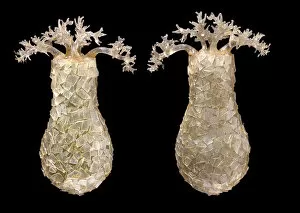Amoebozoa Collection
Amoebozoa, a diverse group of organisms, includes fascinating species such as the Foraminifer model
All Professionally Made to Order for Quick Shipping
Amoebozoa, a diverse group of organisms, includes fascinating species such as the Foraminifer model. These single-celled creatures exhibit intricate shells and play crucial roles in marine ecosystems. Another well-known member is the Amoeba proteus, a giant amoeba that constantly changes its shape as it engulfs prey. Amoebae like Difflugia pyriformis also captivate with their beautiful shell designs. In terrestrial environments, we encounter peculiar organisms like Lycogala epidendrum, commonly known as Wolf's Milk. This gelatinous slime mold forms vibrant pinkish fruiting bodies that release spores into the surroundings. Similarly intriguing are Myxomycetes or plasmodial slime molds which exist as large masses called plasmodia. These brightly colored structures move slowly across forest floors, absorbing nutrients along their path. Foraminifera models provide invaluable insights into these ancient marine protists' evolution and ecology. Their intricate shells serve not only to protect but also to record environmental conditions throughout history. Ostracods coexist with Foraminifera in aquatic habitats and can be observed through detailed models too. Amongst this vast array of microscopic wonders lies Hartmannella vermiformis protozoa cysts C016 / 9401 and C016 / 9402 – two distinct forms of cysts produced by this particular species during unfavorable conditions for survival. Amoebozoa encompasses an astonishing diversity of lifeforms that continue to amaze scientists worldwide. Exploring their intricacies sheds light on our planet's complex web of life and reminds us how interconnected all living beings truly are.












